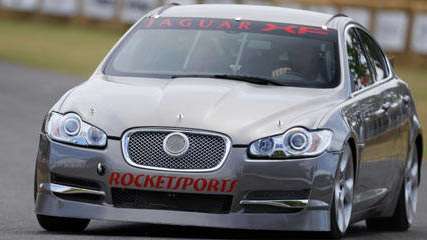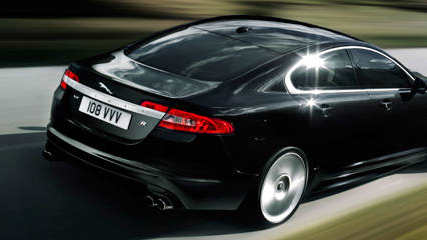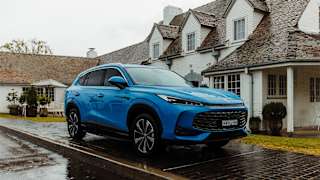Jaguar XF 2009 review
By Neil McDonald · 19 Jun 2009
It might not look it from the outside, but Jaguar has been quietly honing its XF sedan into a formidable fighting machine to go into battle against the German trio of Audi, Mercedes-Benz, BMW and Lexus.Buyers now have a choice of two all-new direct-injection Gen III 5.0-litre V8s, but the big news is the new twin-turbo V6 turbo-diesel and the arrival of a high performance supercharged XFR.The revised models are expected to continue the modest resurgence for the brand locally since the XF arrived here late last year. The average age of the XF buyer, 44, is also helping drag down the traditional Jaguar buyer profile, which has fallen from 55 to 49 across the brand since the XF was launched.More than 500 have been sold and the car has single-handedly underpinned Jaguars local sales.With the exception of the 3.0-litre petrol V6, the three other XF models have received significant makeovers in the engine and performance departments.The new 5.0-litre supercharged V8 XFR replaces the previous range-topper, the supercharged 4.2-litre V8.The 3.0-litre petrol V6 remains the entry car, but the big news is the new performance 3.0-litre twin-turbodiesel V6, which will go up against the turbo-diesels from Audi, BMW and Mercedes-Benz.This engine replaces the previous 2.7-litre engine but has significantly more power and torque, delivering 202kW at 4000 revs and 600Nm from 2000 revs.It is 33 per cent more powerful than the smaller 2.7-litre engine but also 10 per cent more economical with a combined fuel economy figure of 6.8L/100km.Importantly too, the engine emits 179g/km CO2 emissions, which is 10 per cent more than the 2.7-litre engine.Jaguar has managed to extract the power and torque gains out of the diesel through the parallel sequential twin-turbos, which keep performance at both low and high revs. The aim is to eliminate any turbo-lag at any speed.ExteriorThe biggest improvements are reserved for the XFR, which gets a tricked-up exterior package to suit the extra power.Visually, there are revised bumpers, lower front air intakes, discrete body kit, bonnet louvres and grilles, quad exhausts and a small bootlid spoiler.The other XFs get a choice of new alloys and some cosmetic interior updates.All models also get a stiffer rear sub-frame, stronger differentials, upgraded brakes, improved navigation system, acoustic laminated windscreen and an upgraded ZF six-speed automatic.PricingThe entry V6 petrol is now $109,450, a modest price jump over the previous model but diesel pricing has risen to $116,250, up almost $8000. The naturally-aspirated V8 is $147,900 and $208,450 for the XFR.Platform and equipmentThe XF basics really needed little massaging. The platform of this car is proven and typically Jaguar. There's an all-encompassing ride quality that befits the brand, while the quality and equipment of the XF has helped lift Jaguars reputation to levels unseen in recent past years.There is the expected safety suite of six airbags, anti-skid brakes, traction control, dynamic stability control and immensely strong body. This is supplemented by cruise control, LED rear tail-lights, leather trim, rain-sensing wipers, rear parking sensors, automatic climate control and 7-inch colour touch-screen.The Portfolio pack is really the only option. Its about $22,000 on the diesel and about $11,000 on the naturally-aspirated V8.Spend the extra and you get a sort of poor-man's XFR. There are 20-inch wheels, up-spec leather interior with electric heated and cooled seats, suede-like cloth headlining, television, voice control, tyre pressure monitoring and premium sound system.DrivetrainMuch of the XF makeover has been reserved for the powertrains.All are mated to six-speed sequential automatics with the V6 petrol remaining the entry car, developing 175kW at 6800 revs and 293Nm at 4100 revs.Both the 3.0-litre turbo-diesel V6 and the 5.0-litre V8s are new. The 3.0-litre diesel is a development of the trusty PSA-developed 2.7-litre turbo-diesel but light-years ahead in refinement and performance. The engine will also appear in various Land Rover models, including the new Range Rover.The 3.0-litre diesel S develops 202kW at 4000 revs and 600Nm from 2000 revs, just 25Nm shy of the supercharged 5.0-litre V8.The V8s are almost all new, just two carryover parts remain from the 4.2-litre: a cylinder head bolt and supercharger tappet. The XF's chief program engineer, Kevin Stride, says the engines were solely Jaguar-designed and developed and have nothing in common with the latest V8s coming out of Ford in the United States.Both V8s employ direct injection, with the naturally aspirated version delivering 283kW at 6500 revs and 515Nm at 3500 revs while the supercharged engine ups the ante with 375kW at 6000 revs and 625Nm from 2500 revs.The naturally-aspirated V8 delivers 11.1 litres/100km with a CO2 figure of 264g/km, while the supercharged engine delivers 12.5 litres/100km and 292g/km.Zero to 100km/h in the naturally aspirated V8 is dispatched in 5.7 seconds, while the XKR does the same sprint in 4.9 seconds. The big surprise is the turbo-diesel, which is no slow coach. It hits 100km/h in a respectable 6.4 seconds.In keeping with the XFR's extra grunt, Jaguar has specified a new active differential control system and adaptive dynamics (another phrase for a computer control suspension) as well as a faster steering ratio and larger brakes.The active differential is essentially a sophisticated electronic limited slip differential. When not needed, the system is switched off. So unlike a mechanical system, there is no risk of undesirable understeer at low speeds. Another refinement of the Jag active diff is that creates no noise, vibration or harshness problems at low speeds.The adaptive suspension system monitors and adjusts damping to suit the road conditions in a similar manner to the CATS systems seen on previous Jaguars.The new system is configured to rapidly assess body motion and steering wheel input to modulate the damping forces and reduce roll and pitch.DrivingIN today's modern turbo-diesel cars, we're seeing the type of torque numbers that were once the preserve of high-performance V8 petrol engines.The XF's new twin-turbo 3.0-litre V6 is one of them. With 600Nm it is just 25Nm shy of the supercharged petrol V8, yet delivers its peak torque lower in the rev range. According to Jaguar the primary turbo has 61 per cent more torque at 1500 revs than the 2.7 while the secondary turbo has 32 per cent more power at 4000 revs.What does this mean for drivers? Well, don't dismiss the S badge on the XFs boot.It will launch itself from standstill with not so much as a hefty shove like the XKR, but more of a very firm seat-of-the-pants push that delivers loads of torque way beyond the point where most diesels are gasping for breath.The diesel shows the right stuff at overtaking speeds. How does 3.2 seconds to accelerate from 80km/h to 112km/h sound?Its a refreshingly petrol-like V6 too. Crank the ignition and we had to open the door to establish whether it was, in fact, a diesel. There is little rattle at idle and most people would not even know it was a diesel, except if they looked at the fuel economy (8.3 litres/100km in spirited driving) or the rev counter.And if the diesel is not your cup of tea, then there's the supercharged 5.0-litre V8 in the XFR.What can we say, except that this engine is truly a delight. Pedal reasonably quickly and it returned 12.9 litres/100km, within a whisker of Jaguar's own figures.What is amazing is the effortless delivery of power, the crisp, linear steering and surprisingly compliant, yet firm ride. Even with the 20-inch wheels and alloys, the XFR rides incredibly well. It's a sort of luxury sports ride if you like.Look out AMG and M, there's a new kid from Jaguar to tickle your performance figures.Engines: 3.0-litre petrol V6, 3.0-litre twin-turbo diesel S, 5.0-litre Gen III V8 and 5.0-litre Gen III supercharged V8.Power: 175kW at 6800 revs (V6 petrol), 202kW at 4000 revs (V6 S diesel), 283kW at 6500 revs (5.0-litre V8), 375kW at 6000 revs (5.0-litre supercharged V8)Torque: 293Nm at 4100 revs (V6 petrol), 600Nm from 2000 revs (V6 S diesel), 515Nm at 3500 revs (5.0-litre V8), 625Nm from 2500 revs (5.0-litre supercharged V8)














